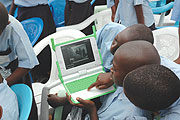The government’s target of the one laptop per child programme to reach at least 50 percent of the primary school-going children by 2012, may be difficult to realise, given the rate at which the distribution exercise is moving a year after its launch.


The government’s target of the one laptop per child programme to reach at least 50 percent of the primary school-going children by 2012, may be difficult to realise, given the rate at which the distribution exercise is moving a year after its launch.
The Economic Development and Poverty Reduction Strategy (EDPRS)’s target is to at least distribute the laptops to half the population of the school going children which is projected to be at 2.5 million by 2012.
That would mean a minimum of 1.25 million children would be equipped with the computers.
That would also imply that at least 250,000 computers a year would be dispatched consistently for the next five years if the target is to be realised.
However, according to the information from OLPC programme in the Ministry of Education, presently, only 8000 laptops have been distributed to less than fifteen primary schools in the country, and these are both public and private schools.
However, when contacted by The New Times, Richard Niyonkuru, the OLPC coordinator in the Ministry of Education, sounded pessimistic on the possibility of realising the set target.
"It looks like the programme is not having enough financing that can lead to its realisation like the EDPRS had projected,” Niyonkuru said.
He said, they have been able to distribute the laptops in nine public and six private schools in Kigali city where parents have been able to buy the laptops for their children.
Rwanda is the global learning centre of OLPC and was chosen due to its commitment to becoming an ICT hub on the continent.
The centre in Kigali is supposed to train national, regional and international specialists in order to expand the laptop learning programme in their respective countries.
Ends


